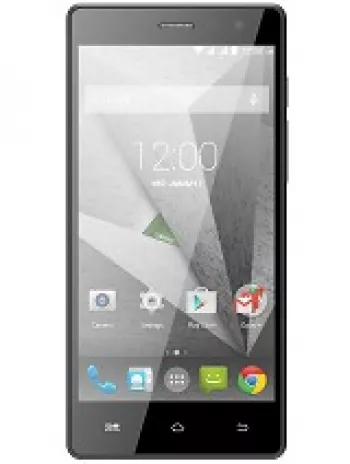
Design and Build Quality
The Gigabyte GSmart Maya M1 was first announced and released in April 2013. The device measures 136 x 67 x 9.7 mm and weighs approximately 150.5 g, making it a relatively portable smartphone with a comfortable grip. Its design features a dual SIM (Mini-SIM, dual stand-by) capability, which was a selling point for users looking for flexibility in managing multiple phone numbers. The phone was available in multiple color options, including Brown, Brown/White, and Brown/Red, offering a bit of variety to consumers.
Display Characteristics
The device is equipped with a 4.5-inch IPS LCD display, which covers about 61.3% of the front surface. With a resolution of 540 x 960 pixels and a pixel density of approximately 245 ppi, the screen offers decent sharpness and viewing angles for everyday tasks. While not outstanding by today's standards, at the time of its release, the display was adequate for watching videos, browsing the internet, and handling everyday smartphone tasks.
Performance and Hardware
Under the hood, the Gigabyte GSmart Maya M1 is powered by a Mediatek MT6577 chipset built on a 40 nm process. It houses a dual-core 1.0 GHz Cortex-A9 CPU and a PowerVR SGX531u GPU. These specifications positioned the Maya M1 as a budget-friendly smartphone capable of handling basic tasks but not designed for heavy multitasking or demanding applications. The device includes 1GB of RAM and 4GB of internal storage, which could be expanded via a microSDHC card. However, the limited internal storage may have required users to rely on external storage solutions for apps and multimedia.
Camera Capabilities
The main camera on the GSmart Maya M1 features an 8 MP sensor with autofocus and dual-LED flash. It can capture video at 480p@30fps, which is quite limited compared to contemporary smartphones but was common for budget devices at the time. Despite its modest capabilities, the camera was suitable for casual photography and capturing memorable moments. The front-facing camera is 2 MP, suitable for video calls and basic selfies.
Battery Life
The phone is powered by a removable Li-Ion 1700 mAh battery, which offers standby time of up to 300 hours and talk time of up to 4 hours. These figures reflect modest battery performance, typical for smartphones of that era. Users could manage a full day of light to moderate use, but heavy users might have needed to recharge during the day.
Network and Connectivity
The Maya M1 supports GSM/HSPA technology, with 2G bands covering GSM 850/900/1800/1900 for both SIM slots and 3G support via HSDPA. The maximum network speed supported is HSPA 7.2/5.76 Mbps, providing basic mobile internet functionality. Connectivity options include Wi-Fi 802.11 b/g/n, Bluetooth 3.0, GPS for positioning, FM radio support, and a microUSB 2.0 port. However, it lacks NFC capabilities, which may limit its use with contactless payment systems.
Software Experience
The Gigabyte GSmart Maya M1 runs on Android 4.1 (Jelly Bean), which, at the time of its release, offered a fluid user experience with many features that were innovative at the time. Some of these included Google Now, which brought contextual search and voice commands, and Project Butter, which improved the system's overall performance and responsiveness.
Sensors and Miscellaneous Features
The device comes equipped with sensors such as an accelerometer, proximity sensor, and compass. These sensors enable various features and functionalities, including screen rotation, detecting the device's orientation, and navigation support.
Price and Market Position
Priced at approximately 220 EUR during its release, the GSmart Maya M1 was positioned as an affordable smartphone option for consumers looking for dual SIM support and Android operating capabilities without breaking the bank. Despite being discontinued, it remains a reference point for budget smartphone offerings from that era.
Key Features of Gigabyte GSmart Maya M1
- Dual SIM capability with dual standby
- 4.5-inch IPS LCD display with 540 x 960 pixels resolution
- Powered by Android 4.1 (Jelly Bean)
- Equipped with Mediatek MT6577 chipset and Dual-core 1.0 GHz Cortex-A9 CPU
- Comes with 4GB internal storage and 1GB RAM, expandable via microSDHC slot
- Main camera: 8 MP with autofocus and dual-LED flash
- 2 MP front-facing camera for selfies
- Supports Wi-Fi 802.11 b/g/n and offers Wi-Fi hotspot capabilities
- Includes essential sensors: Accelerometer, proximity, and compass
- Removable Li-Ion 1700 mAh battery with up to 300 hours of standby time
- Comes with FM radio and a 3.5mm headphone jack
Disadvantages of Gigabyte GSmart Maya M1
- Discontinued model, making it difficult to find support and replacement parts.
- Low screen resolution of 540 x 960 pixels which might not provide the best viewing experience.
- Limited processing power with a Dual-core 1.0 GHz CPU.
- Runs on outdated Android 4.1 (Jelly Bean) operating system.
- Minimal internal storage of 4GB, which can easily be exhausted with apps and media.
- 8 MP main camera with low video resolution of 480p@30fps.
- Older Bluetooth version 3.0, lacking energy-efficient features of newer versions.
- No support for NFC, limiting mobile payment options.
- Rather short talk time of up to 4 hours due to a 1700 mAh battery.
- Relatively high SAR level of 0.75 W/kg (head) which might be a concern for some users.
- High initial price point of about 220 EUR given the specifications.


View Also
More Phones
All Rights Reserved +13665 Phones © Mobilawy 2025

























